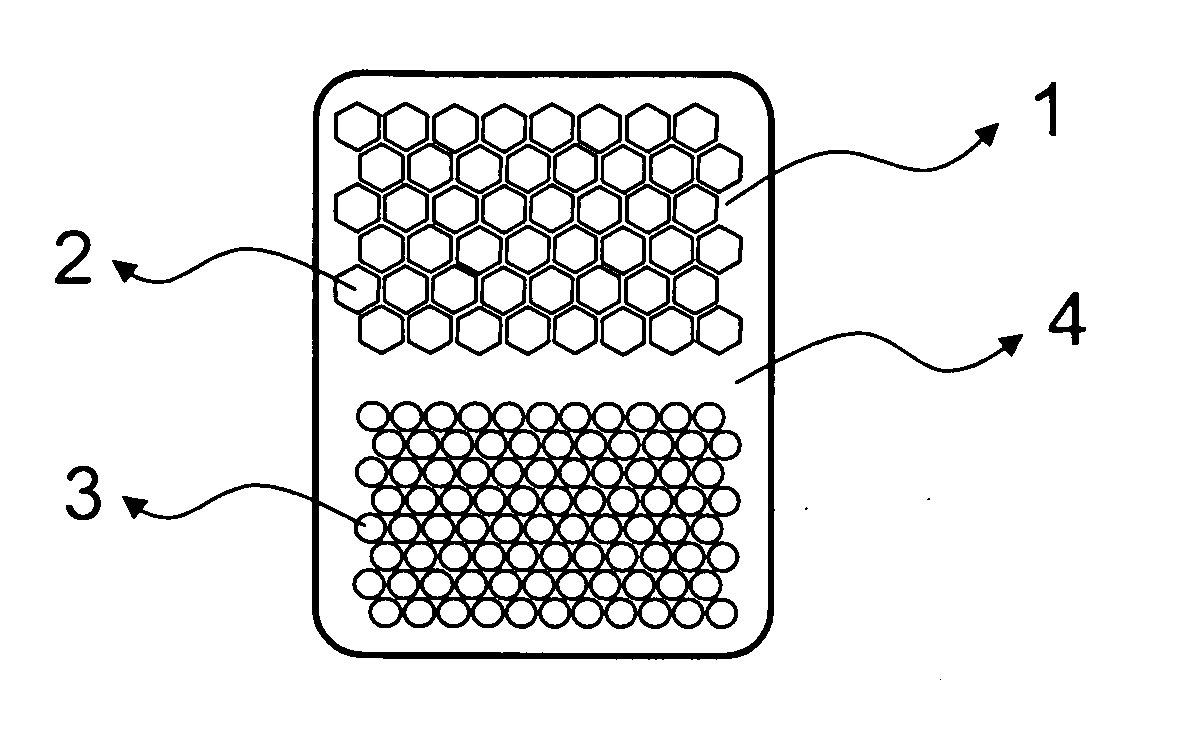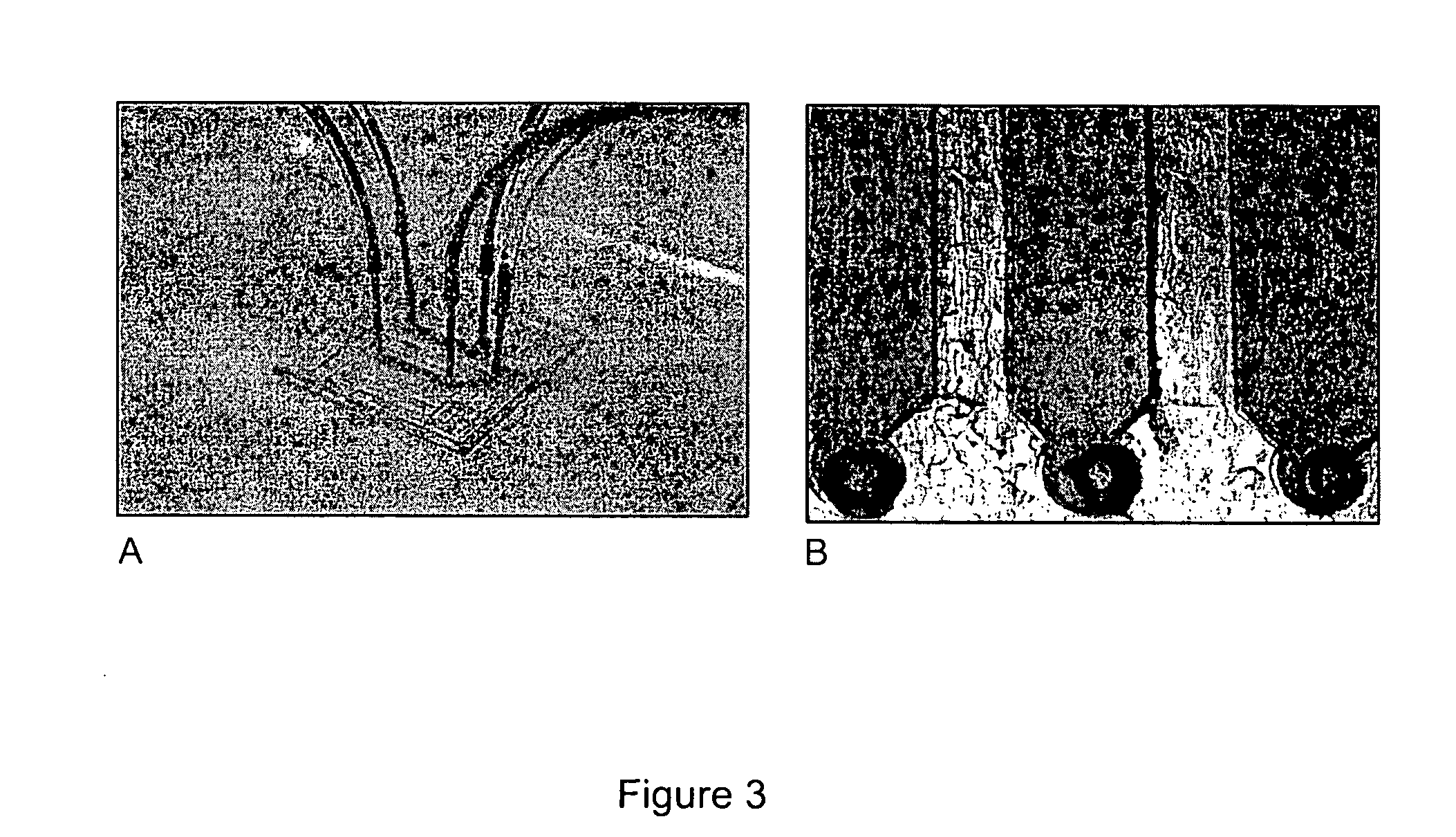Honeycomb shrink wells for stem cell culture
a technology of stem cell culture and shrink well, which is applied in the field of shrink well for stem cell culture, can solve the problems of manual labor and achieve the effect of reducing the surface area and the surface area
- Summary
- Abstract
- Description
- Claims
- Application Information
AI Technical Summary
Benefits of technology
Problems solved by technology
Method used
Image
Examples
example 1
[0108]The microwells can be designed in AutoCad 2002 (AutoDesk, San Rafael, Calif.). Using a Hewlett-Packard LaserJet 2200D, designs are printed onto the polystyrene thermoplastic sheets (Shrinky Dinks, K &B Innovations, North Lake, Wis.) that resemble transparencies. These thermoplastic sheets are then fed through the printer several times for additional height and / or multi-dimensional wells.
[0109]The printed sheet is placed in an oven for about 3-5 minutes at 163° Celsius. Both a standard toaster oven as well as a laboratory-grade oven can be used. Whereas slight warping can result from the toaster over, heating in the pre-heated lab oven resulted in more uniform heating. The devices were heated on a glass microscope slide for even more uniform and flat baking. It was found that the slides should not be pre-heated or they will melt the plastic.
[0110]The thermoplastic sheet naturally curls while shrinking to make the mold. Uniform heat on a flat surface will ensure that the thermop...
example 2
[0112]Honeycomb microwells are an inexpensive alternative assay platform for the generation of uniform embryoid bodies derived from pluripotent stem cells, negating the use of photolithography. Honeycomb microwell patterns are created by molding polydimethylsiloxane (PDMS) onto polystyrene molds containing the honeycomb microwell patterns. PDMS microwells are then treated consecutively with non-polar and polar solvents to remove any uncross-linked PDMS monomers. Pluripotent embryonic stem cells (murine or human) are then cultured in the microwells wherein the microwells will induce the uniform aggregation of the pluripotent stem cells in each individual wells, thus allowing the controlled formation of embryoid bodies of various sizes depending on the microwell size. Due to the close spacing of the wells, analogous to that of honeycomb structures, cells which are uniformly dispersed will fall randomly into the wells and due to the curvature, depth, spacing and hydrophobic properties ...
example 3
[0120]A modification of the culturing methodology has been devised by the inventors. hESCs die during single cell dissociation (Ungrin, D. M. et al. (2008) PLoS ONE Vol. 3, e1565). Microwells require uniform single cell suspension, hence ROCK inhibitor (ROCKi) Y27632 (Watanabe, K. et al. (2007) Nature Biotechnology, 25(6); Leverrier, Y. et al. (2001) Nature Cell Biology, Vol. 3; Shi, J. et al. (2007) Arch. Immunol. Ther. Exp., 55:61-75; and Ishizaki, T. et al. (2000) Molecular Pharmacology, 57:976-983) is used at approximately 10 μM to prevent cell death. It is within the scope of this invention to modify the amount of ROCK inhibitor from approximately 5 to 15 μM, or about 6 to 14 μM, or about 7 to 13 μM, or about 8 to 12 μM or about 9 to 11 μM, as determined by those of skill in the art. Thereafter, cells are dissociated in 10 μM ROCKi and suspended culture medium containing 10 μM ROCKi. It is within the scope of this invention to modify the amount of ROCK inhibitor from approximat...
PUM
| Property | Measurement | Unit |
|---|---|---|
| Fraction | aaaaa | aaaaa |
| Fraction | aaaaa | aaaaa |
| Diameter | aaaaa | aaaaa |
Abstract
Description
Claims
Application Information
 Login to View More
Login to View More - R&D
- Intellectual Property
- Life Sciences
- Materials
- Tech Scout
- Unparalleled Data Quality
- Higher Quality Content
- 60% Fewer Hallucinations
Browse by: Latest US Patents, China's latest patents, Technical Efficacy Thesaurus, Application Domain, Technology Topic, Popular Technical Reports.
© 2025 PatSnap. All rights reserved.Legal|Privacy policy|Modern Slavery Act Transparency Statement|Sitemap|About US| Contact US: help@patsnap.com



